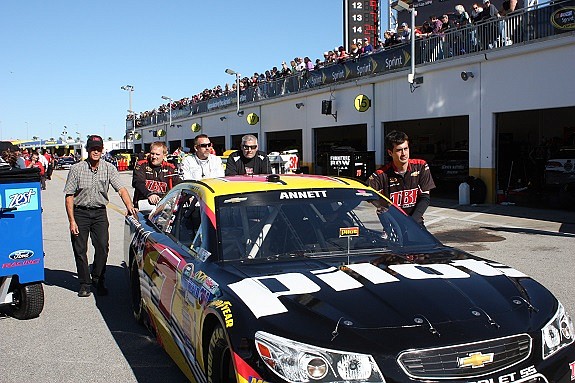- February 28, 2025

After Sprint Unlimited turns out to be limited, local crew chief prepares for Daytona 500.
BY WAYNE GRANT | STAFF WRITER
Apparently one of the items removed from a race car for weight is the horn. That’s why the NASCAR driver on his way to the track had to swerve around me instead of beeping as I walked through the middle of the garage area.
An official politely explained I was supposed to walk over on the side. “They’re not going to stop,” he said.
It was my first time in the busy garage area in the World Center of Racing. I started to pay more attention after that, as I wanted to return to the regular world alive.
That night, my assignment was to watch the race from Jeff Gordon’s pit, monitoring the talk between Gordon and his crew chief, Alan Gustafson, of Ormond Beach. But I had time before the race to check out the garage.
NASCAR nation is a bustling, noisy city in the middle of our quiet beach town. The stands span the horizon, looking like they could hold every race fan in the world — and the sea of RVs in the infield look like they could have delivered them.
During races and practices, the cars' thunder barrels around the track. It’s an earth-shaking, deep and almost primeval sound. It’s almost as loud as the PA system when it blares rock music, ads and track promotions.
The garage area itself is a swirling crowd of people, all busy and on a mission: NASCAR and speedway officials, reporters carrying microphones and cameras, crew members focused and hurried, and sometimes, suddenly, a star of the show appears.
A driver walks through the area as fans outside the fence call their name. He carries the mystique of the matador but wears a suit of sponsors rather than a suit of lights.
As the race nears, the action shifts to Pit Road. Tires are stacked and the fuel cans are filled. The crews make final checks on tools and a lot of them stretch in anticipation.
Crew Chief Gustafson sat elevated above the pit behind three computer monitors, which showed TV footage of the race, as well as data calculating tire wear, fuel consumption and more. It's a far cry from days gone by, when the crew chief watched the race with binoculars.
It’s quiet in the pit until the cars blur by, shining under the lights.
The calm is interrupted when the cars come tearing in for a pit stop. In an orchestrated ballet, tires are changed and fuel is added before you can even focus a camera. It makes you wonder why you have to leave your car at the garage all day for a tire rotation.
Throughout the race, the crew chief communicates with his driver, letting him know his position and what other drivers are doing.
“Newman has three lined up behind you. You’re going to get a shove,” Gustafson told Gordon. “It’s three-wide ahead.”
“How many laps to go?” Gordon asked.
Races are often won and lost by pit stop strategy, determined by the crew chief with input from the driver.
“The pit crew makes decisions on when to pit,” Gustafson said later. “Sometimes, the driver won’t agree. He’s in the heat of the moment. We like to make the pit decisions based on science and not just off the cuff, but he might know of an issue with the car.”
Decisions on when to pass or hang in a drafting line are made by the driver.
“Things happen fast, and the driver has to make those decisions,” Gustafson said. “We discuss a strategy before the race, and it’s his job to carry it out.”
Things happened fast in the Sprint Unlimited last Saturday. About halfway through the race, a car drifted across the track, collided with another car and, as often happens at Daytona, the collision caused a series of spins and crashes that ended the night for several drivers, including Gustafson’s: Jeff Gordan.
The final words over the Gustafson-Gordan radio that night just after the crash:
The spotter: “Goshdarnit.”
Gustafson to Gordan, “You OK, Bud?”
Gordan: “Yeah, I’m OK.”
It was an early night for the Gordon-Gustavson team, but they race again this Sunday in the Daytona 500.